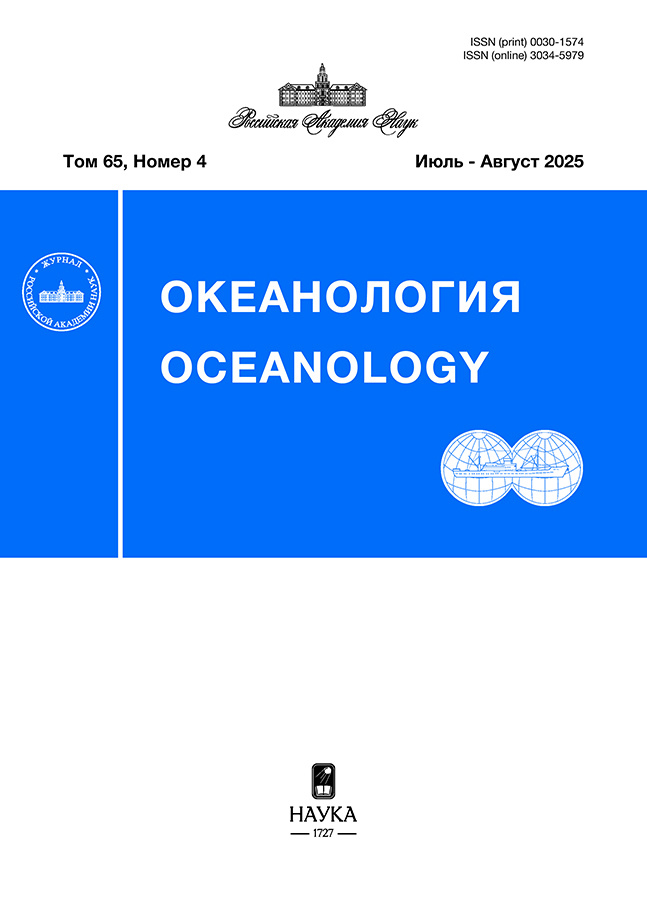The effect of small doses of γ-radiation on carbon assimilation by a natural community of microplankton
- Autores: Domanov M.M.1, Demidov A.B.1, Sukhanova I.N.1
-
Afiliações:
- Shirshov Institute of Oceanology Russian Academy of Science
- Edição: Volume 65, Nº 4 (2025)
- Páginas: 618-626
- Seção: Химия моря
- URL: https://journals.eco-vector.com/0030-1574/article/view/692404
- DOI: https://doi.org/10.31857/S0030157425040073
- ID: 692404
Citar
Texto integral
Resumo
In the Kara Sea, a study was conducted on the effect of small doses of γ-radiation from an external source of 40K (Eγ=1.46 MeV) on the process of carbon assimilation by a natural population of microplankton. The results of measuring the rate of carbon assimilation by the plankton community under the influence of γ-radiation from external sources with an activity of 269 Bq and 376 Bq showed a multidirectional effect of its influence on carbon assimilation in the light and in the dark. In the surface layer, the rate of carbon assimilation in light samples with a source activity of 269 Bq increased by an average of 1.2 times. It was shown that with a γ-radiation source activity of 376 Bq, the average rate of carbon assimilation in the light increases by an average of 1.4 times. A comparison of the rate of dark carbon assimilation in γ-radiation from sources with an activity of 269 Bq and 376 Bq showed its decrease by an average of 1.6 times relative to the background, regardless of the dose rate.
Palavras-chave
Sobre autores
M. Domanov
Shirshov Institute of Oceanology Russian Academy of Science
Email: domanov@ocean.ru
Moscow, Russia
A. Demidov
Shirshov Institute of Oceanology Russian Academy of ScienceMoscow, Russia
I. Sukhanova
Shirshov Institute of Oceanology Russian Academy of ScienceMoscow, Russia
Bibliografia
- Антонова Н.Н., Зайцев В.В. К вопросу о калибровке кривой Басби-Бурлаковой при малых дозах ионизирующего облучения // Материалы Международной конференции “Биологические эффекты малых доз ионизирующей радиации и радиоактивное загрязнение среды”. Сыктывкар, 2014. С. 19–22.
- Гудков С.В. Частные вопросы радиационной биофизики: Учебное пособие. Нижний Новгород: Нижегородский государственный университет им. Н.И. Лобачевского, 2022. 235 с.
- Киселев И.А. Планктон морей и континентальных водоемов. Л.: Наука, 1969. 367 с.
- Кузин А.М. Природный радиоактивный фон и его значение для биосферы Земли. М.: Наука, 1991. 116 с.
- Лапин С.А. Особенности формирования пресноводного стока в эстуарных системах Оби и Енисея // Труды ВНИРО. 2017. Т. 166. С. 139–150.
- Мокроносов А.Т. Фотосинтетическая и гетеротрофная ассимиляция углерода в онтогенезе растений. Автореферат диссертации на соискание ученой степени доктора биологических наук / Институт физиологии растений им К.А. Тимирязева Академии Наук СССР. М., 1966. 42 c.
- Пряхин Е.А., Духовная Н.И., Тряпицына Г.А. и др. Фитопланктон водоема В–11 Теченского каскада водоемов ПО “Маяк” // Радиац. биология. Радиоэкология. 2010. Т. 50. № 4. С. 423–433.
- Степанова С.В., Недоспасов А.А. Особенности гидрофизического и гидрохимического режимов залива Благополучия (Новая Земля) // Океанология. 2017. Т. 57. № 1. С. 75–85.
- Суханова И.Н. Концентрирование фитопланктона в пробе // Современные методы количественной оценки распределения морского планктона / Под ред. М.Е. Виноградова. М.: Наука, 1983. С. 97–105.
- Adams G.E.D. 1986. Radiation carcinogesis. In Introductin of the Cellular and Molecular Biology of Cancer. Edited by L.M. Franks and N. Teich (Oxford. Oxford University Press). P. 154–175.
- Ahuja S., Kumar M., Kumar P. et al. Metabolic and biochemical changes caused by gamma irradiation in plants // J. Radioanal. Nucl. Chem. 2014. V. 300. P. 1–14.
- De Micco V., Arena C., Pignalosa D., Durante M. Effects of Sparsely and Densely Ionizing Radiation on Plants // Radiation and Environmental Biophysics. 2011. V. 50 (1). P. 1–19.
- Effects of ionizing radiation on aquatic organisms and ecosystems. IAEA, VIENNA, 1976. STI/DOC/10/17 2 ISBN 92-0-125076-2 143. International Atomic Energy Agency VIENNA, 1976. Technical Reports Series No. 172.
- Geras’kin S.A., Dikarev V.G., Zyablitskaya Ye. Ya. et al. Genetic consequences of radioactive contamination by the Chernobyl fallout to agricultural crops // J. Environ. Radioactiv. 2003. V. 66. Iss.1–2. P. 155–169.
- Gudkov S.V., Grinberg M.A., Sukhov V., Vodeneev V. Effect of ionizing radiation on physiological and molecular processes in plants // Journ. Of Env. Radioact. 2019. V. 202. P. 8–24.
- Jan S., Parween T., Siddiqi T.O., Mahmooduzzafar. Effect of gamma radiation on morphological, biochemical, and physiological aspects of plants and plant products // Environ. Rev. 2012. V. 20. № 1. P. 17–39.
- Luckey T.D. Hormesis with Ionizing Radiation. Tokyo: Boca Raton Publisher CRC Press, 1980. 222 p.
- Menden-Deuer S., Lessard E.J. Carbon to volume relationships for dinoflagellates, diatoms and other protist plankton // Limnol. Oceanogr. 2000. V. 45. № 3. P. 569–579.
- Parsons P.A. Radiation hormesis: an evolutionary expectation and the evidence // International Journal of Radiation Applications and Instrumentation. 1990. V. 41. № 9. P. 857–860.
- Prakash A., Sheldon R., Sutcliffe Jr.W. Geographic variation of oceanic 14C dark uptake // Limnol. Oceanogr. 1991. V. 36. № 1. P. 30–39.
- Richardson K. Comparison of 14C primary production determinations made by different laboratories // Mar. Ecol. Progr. Ser. 1991. V. 72. P. 189–201.
- Riley P.A. Free radicals in biology: Oxidative stress and the effects of ionizing radiation // Int. J. Radiat. Biol. 1994. V. 65. № 1. P. 27–33.
- Steemann Nielsen E. The use of radioactive carbon (C14) for measuring organic production in the sea // J. Cons. Perm. Ins. Explor. Mer. 1952. V. 18. P. 117–140.
- Strathmann R.R. Estimating the organic carbon content of phytoplankton from cell volume, cell area or plasma volume // Limnol. Oceanogr. 1967. V.12. № 3. P. 411–418.
- Thørring H., Brown J.E., Hosseini A. Characterization of background dose-rates for marine environments // Radioprotection. 2009. V. 44. № 5. P. 595–600.
Arquivos suplementares









